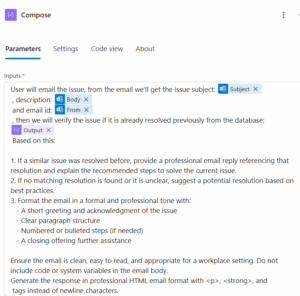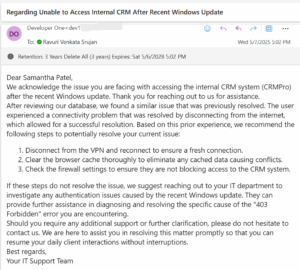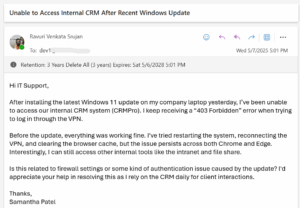Introduction: The Evolution from Automation to Intelligence
Imagine a world where your software tools don’t just do what you tell them but actually understand what you need and take action on your behalf. That’s exactly where we’re headed with the rise of Agentic AI.
To break it down, most automation tools today are rule-based. You set up a flow or a script that says, “If A happens, then do B.” This is incredibly helpful for repetitive tasks, but it requires you to think through all the logic and scenarios in advance. What if we could take that a step further?
What if your automation system could read an email, understand what it means, decide what kind of reply is appropriate, and send that reply without needing you to lift a finger for the support team?
That’s what Agentic AI enables. It’s a new way of designing intelligent workflows that go beyond simple triggers and actions. Instead, these AI agents can:
- Analyze situations dynamically
- Choose the right course of action
- Respond or take steps to achieve a goal
In this blog, we’ll demystify what Agentic AI is, how it can be used in different ways inside Power Automate, and show a real example that brings the concept to life.
What is Agentic AI?
Agentic AI refers to a type of artificial intelligence that acts like an agent. Instead of passively waiting for instructions, it:
- Understands what needs to be done (the goal)
- Processes available information (the context)
- Decides about what to do next
- Takes action to accomplish the task
You can think of Agentic AI as a smart assistant that not only understands what you’re asking but can also figure out how to help without being explicitly told what steps to follow.
For example:
- Traditional AI: “Summarize this paragraph.”
- Agentic AI: “Read this email and either respond, escalate to HR, or ignore if it’s spam.”
Agentic AI is what powers modern tools like ChatGPT with memory, AI copilots, and multi-step assistants in business applications.
How to Incorporate Agentic AI in Power Automate
1. Using Preview Generative Actions (Low-Code)
Microsoft has added new AI-powered actions to Power Automate, such as:
- “Create text with GPT (Preview)”
- “Generative Answers (Preview)”
These allow users to quickly integrate AI into flows without writing code. For example:
- Generate a professional response to a customer complaint.
- Summarize meeting notes automatically.
However, these features are still in preview and may not offer the customization or reliability needed for more complex business use cases.
2. Using Azure OpenAI via HTTP Action (Recommended for Production)
This method offers more flexibility and power:
- You create a prompt that clearly tells the AI what to do.
- You send the prompt and dynamic data (like an email body) to Azure OpenAI using Power Automate’s HTTP action.
- The AI responds with structured content you can act upon.
For instance, you can ask the AI to classify an email as a complaint, inquiry, or feedback and then route it accordingly in your workflow. This method allows full control over prompts, tone, structure, and flow behavior.
3. Using Copilot Studio + Power Automate
Copilot Studio (previously known as Power Virtual Agents) lets you build conversational bots.
These bots can:
- Have interactive conversations with users
- Use Power Automate flows as back-end tools to take action
- Make decisions based on user intent or AI-generated content
You can create bots that help employees find HR resources, troubleshoot IT problems, or complete tasks without any manual intervention. By integrating them with Power Automate, you add the ability for these agents to take meaningful action, not just chat.
Implemented POC: Automatic Email Agent with Azure OpenAI
We wanted to create a flow that automatically reads employee emails, understands their intent, and sends back a helpful, context-aware reply without human intervention.
Steps:
1. Trigger: The flow is triggered when a new email is received.
- The flow is triggered whenever a new email is received in a shared mailbox used for employee support. This is the sample email sent by an employee to the support team.
2. List Rows from Dataverse Table:
- The List Row action fetches the existing queries and its resolutions from a Dataverse table.
3. Compose action for the agent prompt:
- This is the main step where we will structure a prompt for our AI agent/service which contains information on how our reply body should be designed by the AI service.
- This prompt is designed to ask the model to generate a fresh response to the asked query or use an existing solution which was resolved for a similar issue.

4. Send to Azure OpenAI:
- We use an HTTP action to send the above to an Azure OpenAI endpoint.
- Since Generative Actions in Power Automate are still in preview and cannot be executed directly, this HTTP action is used.
5. Receive AI Response: The response contains a draft email that addresses the employee’s concern.
6. Send the Response: The AI-generated content is sent back to the employee using Outlook action.

This is the reply received by the employee to the sent email.
Why Is This Agentic?
Here’s what makes this flow agentic:
- The AI interprets the email’s context and intent.
- It chooses the tone and content of the reply.
- The system then acts by sending email without human review.
- It’s goal-driven, context-aware, and decision-capable.
Key Benefits of Agentic AI in Power Automate
- Smarter decision-making: AI adapts to changing content or situations.
- More human-like communication: Messages are polite, relevant, and personalized.
- Scalable automation: You can handle hundreds of emails without writing hundreds of rules.
- Timesaving: Reduces manual triage, drafting, and task assignment.
A Major Leap Forward in Automation
Agentic AI represents a major leap forward in automation. It enables Power Automate flows that not only execute tasks but also think, plan, and act based on your business goals.
With tools like Azure OpenAI, Copilot Studio, and Power Automate, you can build intelligent systems that reduce workloads, increase responsiveness, and unlock new levels of productivity.
Source: Read MoreÂ


